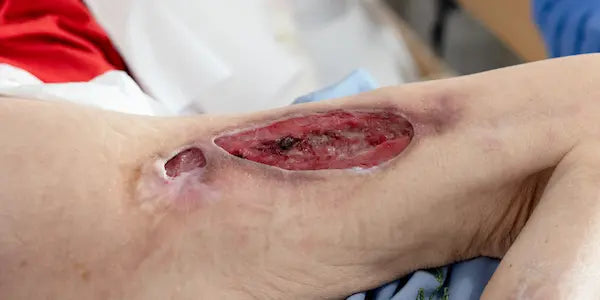It is undeniable that diabetes is a complex and delicate disease that requires special attention to maintain an acceptable quality of life. But, have you ever thought about its connection with pressure sores and chronic wounds ? If this is not the case, we are here to enlighten you on this little-discussed, but oh-so-important subject. As a person living with diabetes or as a caregiver, it is essential to be aware of this risk and learn how to prevent it.
“Diabetes and pressure ulcers may seem like two separate health conditions, but in reality, they are undeniably linked. »
Whether you're new to managing diabetes or have been living with the condition for years, it's crucial to understand how it can affect different parts of your body, including the skin. In the following paragraphs, we will detail how diabetes can promote the appearance of bedsores and chronic wounds , help you understand why this phenomenon occurs and give you advice to prevent these complications.
The Link Between Diabetes and Pressure Sores: What You Need to Know
You who are diabetic or who care for someone with this disease should understand that diabetes can unfortunately contribute to the development of pressure sores . Diabetes is indeed recognized as a risk factor for pressure sores due to the complications specific to this condition.
Among these complications, hypovascularization , that is, a reduction in blood supply to tissues , is one of the most problematic. This situation has the effect of harming the natural healing process and therefore increasing the risk of bedsores appearing. Additionally, diabetic neuropathy, another common complication of diabetes, can reduce skin sensitivity and make wounds less noticeable, until they become serious sores.
Remember also that diabetes can cause what is called " diabetic foot ", a series of complications affecting the feet that can lead to chronic ulcers. Indeed, with diabetes, foot wounds heal poorly and can quickly turn into painful ulcers that are difficult to treat.
To conclude, diabetic patients must control their blood sugar levels well to avoid healing problems. It is therefore essential to adopt a healthy lifestyle and carry out regular medical check-ups to try to avoid the appearance of these chronic wounds.
Studies have also shown encouraging results with the use of specific dressings, for example ANTISCAR , to help healing. Indeed, in diabetic mice, its implementation allowed approximately 25% faster healing and a 50% improvement in skin remodeling.
So stay attentive to your skin and your overall health, you and your diabetic loved ones, to try to preserve your well-being and avoid bedsores and other chronic wounds.
Understanding Diabetes and Its Impact on the Skin
When we talk about diabetes, we often think of the complications it causes on the body's internal organs - the heart, kidneys and eyes. However, let's not forget the skin, our largest exposed surface, which also suffers the consequences of this chronic disease.
You are probably wondering, how does diabetes affect the skin? Well, this is mainly explained by two mechanisms. The first is diabetic neuropathy , a nerve condition caused by diabetes. This leads to a loss of sensation in different parts of the body , with the feet being the most affected area. Therefore, any injury or pressure placed on these areas can go unnoticed and become infected, which can lead to the development of chronic wounds or pressure sores.

The second mechanism is that diabetes causes hypovascularization, or a reduction in blood supply to certain areas of the skin. This situation disrupts the healing process, making the skin more vulnerable to injuries and delays their healing, thus favoring the appearance of bedsores.
Additionally, the disease also impairs the immune system, making it difficult to fight off infections, a common problem with chronic wounds or diabetic foot ulcers.
It is therefore clear that for people with diabetes, skin care is of crucial importance to prevent complications like chronic wounds and pressure sores.
Why Chronic Wounds Are Common Among Diabetics
You may be wondering why people with diabetes are more likely to develop chronic wounds? There are mainly two key factors that make this problem worse: diabetic neuropathy and diabetic foot.
Diabetic neuropathy is a complication of diabetes that affects the nerves. Nerves are responsible for transmitting pain signals, and when they are damaged, a person does not always feel the pain of an injury. Therefore, a small cut or abrasion can go unnoticed and turn into an open wound without proper medical supervision.
Diabetic foot , on the other hand, is another complication of diabetes that can later lead to chronic wounds. Due to decreased sensitivity and blood flow, a minor injury can easily become a serious wound. Additionally, diabetic foot patients can develop ulcers that are slow to heal, exacerbating the risk of chronic wounds.
Additionally, diabetes tends to reduce your ability to heal, which some researchers have observed in diabetic rats. This accelerated poor healing, associated with hypovascularization, aggravates the risk of pressure sores in diabetics. Hypovascularization is a reduction in the amount of blood reaching the skin, making it difficult for cuts and wounds to heal.
Therefore, it is very important for diabetic patients to take proactive steps to manage their blood sugar levels . Effective diabetes management can help prevent nerve and foot complications, and therefore reduce the risk of chronic wounds and pressure sores.
Preventing Chronic Wounds and Pressure Sores in Diabetics
You've probably heard that diabetes can make the skin more vulnerable to infection and injury. This is a fact that has been proven by numerous studies. However, it is also true that even if you have diabetes, it is possible to prevent the appearance of chronic wounds and pressure sores . So how can you make it happen? Let me guide you.

Diabetic foot is one of the most common complications of diabetes. It is caused by two major complications of diabetes: diabetic neuropathy, which can cause loss of sensation in the feet, and hypovascularization, which decreases blood supply to the feet. Together, these conditions can make it very difficult for foot injuries to be detected and healed, which can lead to chronic ulcers.
But don't worry, you can take steps to prevent these problems. For example, you can create a daily foot care routine , which includes visually examining your feet for cuts, blisters, scrapes, or abrasions. If you find anything unusual, make an appointment with your healthcare professional immediately for further examination.
Additionally, be sure to control your blood sugar levels. High blood sugar levels over a long period of time can damage nerves and blood vessels, which can make your skin more vulnerable to sores and infections.
And finally, try to avoid situations that put your feet at risk of injury, such as going barefoot or wearing shoes that don't fit properly. By taking these precautions, you will reduce your risk of developing chronic wounds or pressure sores.
Local and General Treatments for Chronic Wounds
In cases of chronic wounds or pressure sores, appropriate care is necessary to promote proper healing and prevent progression to severe infection. Recent advances have enabled the development of innovative treatments such as ANTISCAR, which can reduce healing time and reduce the risk of infection.
These treatments, whether local or general, must be applied by a healthcare professional who will also monitor the healing process. It is important to follow all care guidelines to ensure a successful recovery.
In short, although diabetes can increase the risk of pressure sores and chronic wounds, good self-care habits and regular medical monitoring can help prevent these complications and manage them when they occur.
Practical Tips for Preventing Chronic Wounds Related to Diabetes
In your fight against diabetes, it is essential to adopt healthy habits to avoid the appearance of chronic wounds. Here are some tips you might find helpful.
Monitor your blood glucose levels: Regulating your blood sugar levels is essential to prevent complications. Be sure to check your blood sugar regularly and follow your doctor's recommendations regarding diet and insulin administration.
Examine your feet daily: Due to diabetic neuropathy, feet can develop ulcers without you noticing. This is why it is recommended to check your feet every day for cuts, blisters, redness or swelling.
Maintain good hygiene: Cleanliness is a crucial factor in preventing wounds. Wash your hands and feet regularly, and keep your nails clean and trimmed. Also be sure to change your socks or stockings frequently to avoid bacteria buildup.
Choose the right shoes: Wear suitable shoes to avoid friction and pressure that could cause ulcers. Consult a healthcare professional for advice on the best options for your feet.
Consult a healthcare professional regularly: Do not neglect the importance of regular visits to your doctor or podiatrist. They will be able to monitor the condition of your feet and help you prevent the formation of ulcers or other complications related to your diabetes.
Prevention is the key to avoiding skin problems related to diabetes. By adopting these recommendations into your daily routine, you will take a big step towards effective health management.
Treating Pressure Sores: What Every Diabetic Should Know
Your fight against diabetes may seem like a constant challenge. However, you should know that effective management of ulcers and pressure sores as complications of diabetes is absolutely possible, as is controlling your blood sugar levels.
The first step in treating diabetes-related pressure sores is to realize that diabetes itself is a risk factor. Hypovascularization, which is a medical term for decreased blood supply, is common in people with diabetes and can increase the risk of pressure ulcers. So, it's important to monitor your skin for early signs of sores, especially if you have diabetic neuropathy.
Next, it is crucial to control your diabetes well. In a recent study, a significant improvement in the healing of chronic wounds and diabetic foot ulcers was observed, reducing both healing time and the risk of infection.
Remember, treating pressure sores isn't just local, it's also a matter of managing blood sugar levels.
Additionally, recent innovations in dressing design have shown promising results. In diabetic mice, a special dressing led to approximately 25% faster healing and a 50% improvement in dermal remodeling. The ultimate goal is to reduce the manufacturing costs of these devices and evaluate their clinical effectiveness, including for other skin pathologies linked to diabetes.
It is therefore essential to continue working with your health care team to control your diabetes and treat potential complications, including pressure sores. This is a mission you can definitely accomplish.







